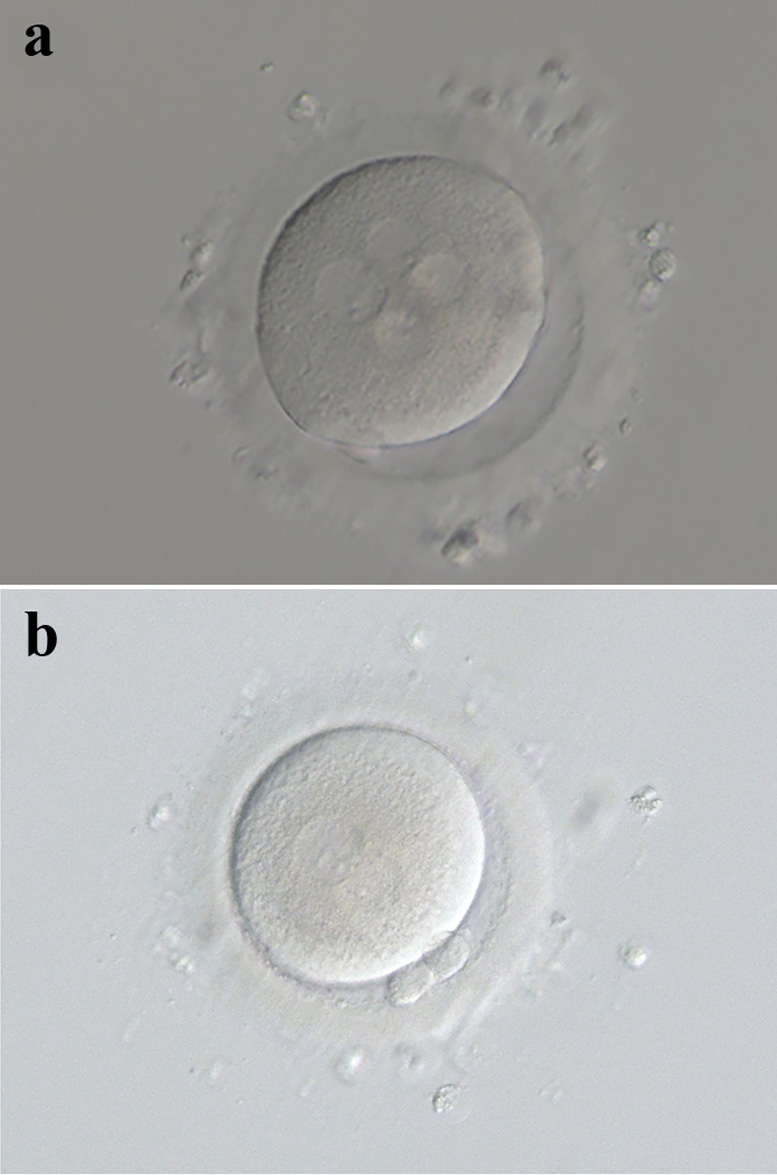| Journal of Medical Cases, ISSN 1923-4155 print, 1923-4163 online, Open Access |
| Article copyright, the authors; Journal compilation copyright, J Med Cases and Elmer Press Inc |
| Journal website http://www.journalmc.org |
Case Report
Volume 9, Number 2, February 2018, pages 52-53
Occurrence of Multinucleated Embryos After Intra-Cytoplasmic Sperm Injection Treatment May Be Prevented by the Administration of Prednisolone
Yuri Iwakia, b, Miyako Funabikia, b, Yoshihiro Tadaa, Masako Karitaa, Terumi Hayashia, Takeharu Otaa, Kazunori Maedaa, Takashi Matsubaraa, Yoshitaka Nakamuraa, Sagiri Taguchia, b, c
aIVF Center, Oak Clinic, Osaka, Japan
bThese authors contributed equally to this work.
cCorresponding Author: Sagiri Taguchi, IVF Center, Oak Clinic, 2-7-9 Tamade-Nishi, Nishinari-ku, Osaka 557-0045, Japan
Manuscript submitted December 11, 2017, accepted December 20, 2017
Short title: Improvement of Multinucleated Embryos
doi: https://doi.org/10.14740/jmc2986w
| Abstract | ▴Top |
The occurrence of multinucleated embryos after intra-cytoplasmic sperm injection (ICSI) treatment may be prevented by the administration of prednisolone.
Keywords: Infertility; Multinucleated embryos; Prednisolone; Pregnancy
| Introduction | ▴Top |
Multinucleated embryos after intra-cytoplasmic sperm injection (ICSI) treatment are often observed. Multinucleated embryos are associated with impaired cleavage and increased fragmentation and compromise the ongoing implantation rate [1]. However, a useful therapy for multinucleated embryos has not been confirmed. Prednisolone is a steroid that prevents the release of substances in the body that cause inflammation. Although prednisolone is used to treat many different inflammatory conditions, the efficacy of this steroid for multinucleated embryos is unclear.
| Case Report | ▴Top |
A 38-year-old woman with infertility visited our clinic in November 2013. She received seven ICSI treatments at our clinic, and prior to each treatment, she was administered clomifene (two tablets per day for 5 days), human menopausal gonadotropin and 0.25 mg cetrotide (cetrorelix acetate for injection). Although calcium ionophore treatment was administered after ICSI treatment, many of the embryos were multinucleated embryos (e.g., 3PN) that could not be transferred.
The patient was positive for anti-centromere antibody. Under the speculation that the existence of the antibody is related to the multinucleated embryos and it can be suppressed by prednisolone, prior to the eighth round of ICSI treatment, she was administered prednisolone (5 mg per day for 14 days) as well as clomifene (two tablets per day for 5 days), human menopausal gonadotropin, and 0.25 mg cetrotide (cetrorelix acetate for injection).
As a result, all of the embryos had two pronuclei on the day after ICSI (Fig. 1a, b), and all of them were cryopreserved. Furthermore, one of those four embryos (2PN) was later used for blastocyst transfer, and clinical pregnancy was confirmed by the observation of a gestational sac (GS) in July 2016. In addition, we confirm that the work in this study was conducted in accordance with the Code of Ethics of the World Medical Association (Declaration of Helsinki). Furthermore, all of the experiments were approved by the institutional review board of Oak Clinic in Japan.
 Click for large image | Figure 1. Efficacy of prednisolone for multinucleated embryos. (a) Before treatment of prednisolone. (b) After treatment of prednisolone. |
| Discussion | ▴Top |
Multinucleation is a common phenomenon. It is seen in 74-79.4% of all cycles [1, 2]. Furthermore, two reports showed that 31% of their embryos were multinucleated [1, 2]. However, a useful therapeutic method for multinucleated embryos has not been confirmed. Therefore, under the speculation that the existence of antibody is related to the multinucleated embryos and that it can be suppressed by predonisolone, prior to the eighth round of ICSI treatment, we administered predonisolone (5 mg per day for 14 days) to a patient. With the result of the case, the occurrence of multinucleated embryos after ICSI treatment was prevented by the administration of predonisolone. However, investigation of the detailed mechanism for the efficacy of predonisolone for multinucleated embryos is necessary in the near future.
Acknowledgments
We are grateful to all members at the Oak Clinic in Japan.
Conflict of Interest
We have no conflict of interest.
Grant Support
The present study is self-funded.
| References | ▴Top |
- Van Royen E, Mangelschots K, Vercruyssen M, De Neubourg D, Valkenburg M, Ryckaert G, Gerris J. Multinucleation in cleavage stage embryos. Hum Reprod. 2003;18(5):1062-1069.
doi pubmed - Jackson KV, Ginsburg ES, Hornstein MD, Rein MS, Clarke RN. Multinucleation in normally fertilized embryos is associated with an accelerated ovulation induction response and lower implantation and pregnancy rates in in vitro fertilization-embryo transfer cycles. Fertil Steril. 1998;70(1):60-66.
doi
This article is distributed under the terms of the Creative Commons Attribution Non-Commercial 4.0 International License, which permits unrestricted non-commercial use, distribution, and reproduction in any medium, provided the original work is properly cited.
Journal of Medical Cases is published by Elmer Press Inc.


